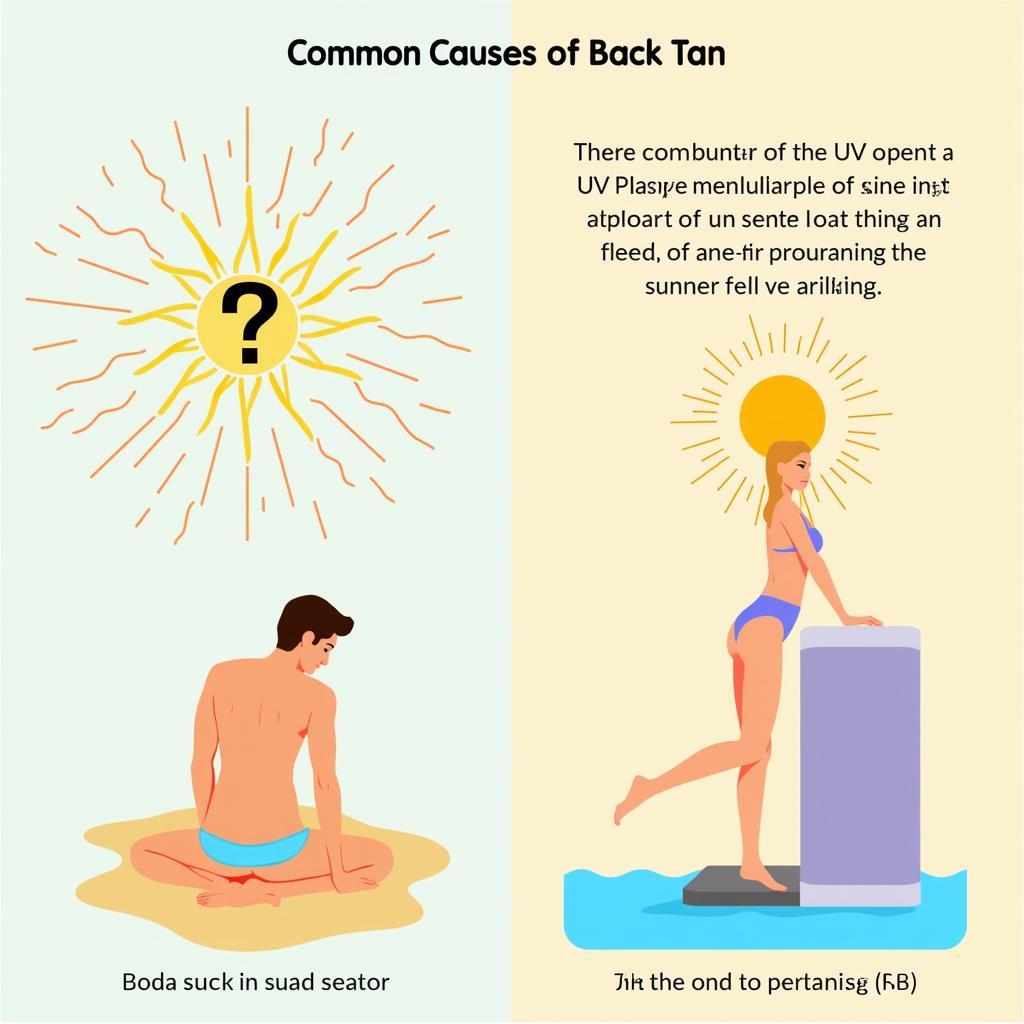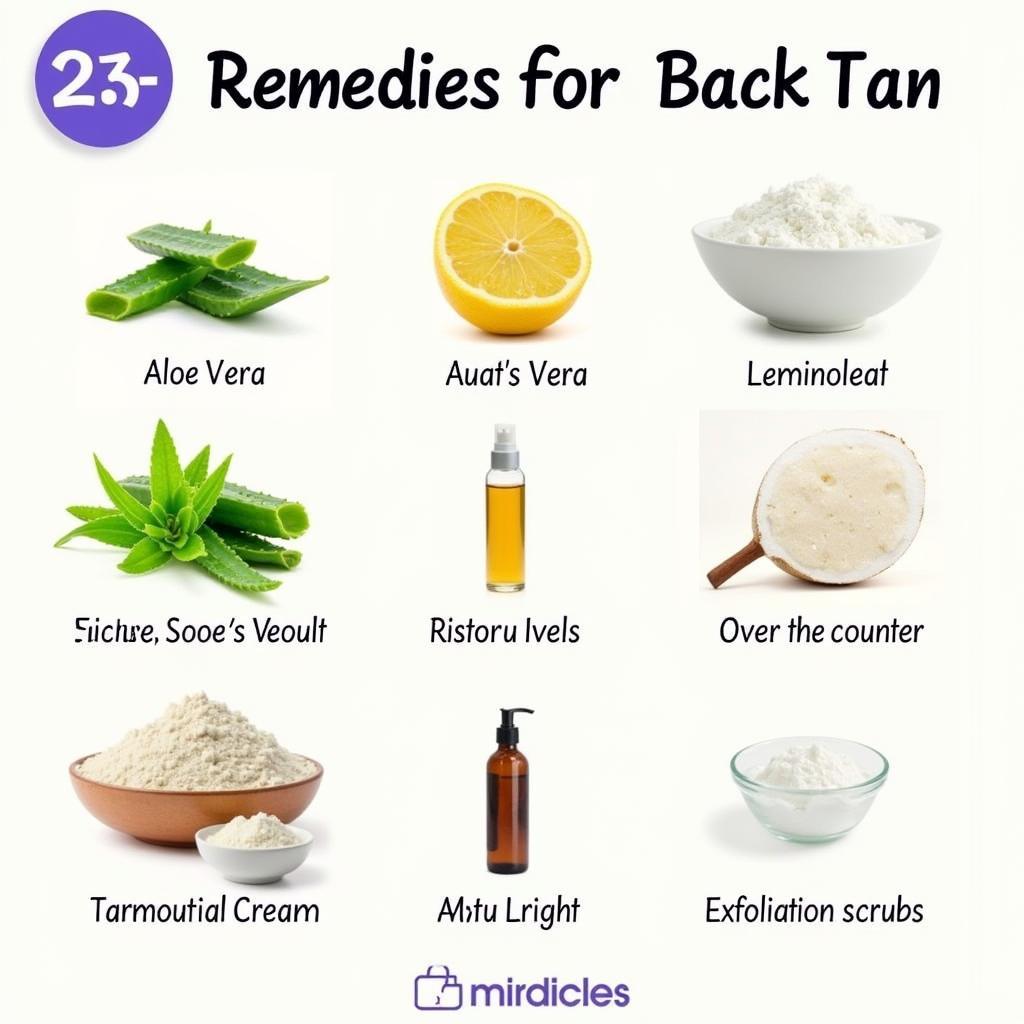Back Tan, a common skin condition often occurring after sun exposure, can be a nuisance. It happens when the skin produces more melanin, the pigment responsible for skin color, to protect itself from UV radiation. This can result in uneven skin tone, making the back appear darker than other body parts. While typically harmless, back tan can sometimes cause discomfort and affect one’s self-esteem.
What Causes Back Tan?
Back tan primarily results from prolonged exposure to ultraviolet (UV) radiation from the sun or tanning beds. When the skin is exposed to UV rays, it triggers the production of melanin, leading to a darker skin tone. The back is particularly susceptible to tanning as it’s often exposed to the sun for extended periods, especially during outdoor activities or while wearing revealing clothing.
 Causes of Back Tan
Causes of Back Tan
Factors Affecting Back Tan Severity
Several factors can influence the severity of back tan, including:
- Skin type: Individuals with lighter skin tones are more prone to sunburn and tanning compared to those with darker skin.
- Duration and intensity of sun exposure: Longer exposure times and higher UV index levels lead to more pronounced tanning.
- Use of sunscreen: Regularly applying sunscreen with a high SPF can significantly reduce the risk and severity of back tan.
- Clothing choices: Wearing protective clothing, such as shirts and hats, can shield the skin from direct sunlight.
Effective Remedies for Back Tan
While back tan typically fades over time, several remedies can help speed up the process and minimize its appearance:
- Exfoliation: Using a gentle exfoliating scrub can help remove dead skin cells, revealing brighter skin underneath.
- Natural ingredients: Applying natural ingredients like aloe vera, yogurt, or lemon juice can soothe the skin and lighten the tan.
- Topical creams: Over-the-counter creams containing ingredients like hydroquinone or kojic acid can help reduce pigmentation.
- Chemical peels: In some cases, dermatologists may recommend chemical peels to exfoliate the skin and lighten the tan.
 Effective Remedies for Back Tan
Effective Remedies for Back Tan
Preventing Back Tan: Essential Tips
Prevention is always better than cure. Here are some tips to help prevent back tan:
- Limit sun exposure: Avoid prolonged sun exposure, especially during peak hours when UV radiation is strongest.
- Wear sunscreen: Apply a broad-spectrum sunscreen with an SPF of 30 or higher to all exposed skin, even on cloudy days.
- Cover up: Wear protective clothing, including wide-brimmed hats, sunglasses, and long-sleeved shirts and pants, when outdoors.
- Seek shade: Take breaks from the sun by seeking shade under trees, umbrellas, or other shelters.
- Avoid tanning beds: Tanning beds emit harmful UV radiation that can damage the skin and increase the risk of skin cancer.
Back Tan vs. Sunburn: Understanding the Difference
While both back tan and sunburn are caused by sun exposure, they differ in their severity and underlying mechanisms.
- Back tan: A gradual process where the skin darkens due to increased melanin production. It’s generally harmless but can sometimes cause uneven skin tone.
- Sunburn: An acute inflammatory reaction caused by overexposure to UV radiation. It results in red, painful, and inflamed skin, and in severe cases, it can lead to blistering and peeling.
Understanding the difference between back tan and sunburn can help individuals take appropriate preventive measures and seek timely treatment when necessary.
When to Consult a Dermatologist
While back tan is usually harmless, it’s essential to consult a dermatologist if:
- The tan is severe or accompanied by pain, itching, or blistering.
- You notice any unusual moles, freckles, or skin changes.
- You have concerns about skin cancer risk factors.
- You’re looking for professional advice on treating or preventing back tan.
“It’s crucial to remember that everyone’s skin reacts differently to sun exposure,” says Dr. Emily Carter, a board-certified dermatologist. “If you have any concerns about back tan or other skin-related issues, seeking professional advice is always recommended.”
 Consulting a Dermatologist for Back Tan
Consulting a Dermatologist for Back Tan
Conclusion
Back tan, a common concern, can be managed effectively with proper care and preventive measures. By understanding the causes, remedies, and prevention tips, individuals can maintain healthy and even-toned skin. Remember to prioritize sun safety, listen to your skin, and seek professional help when needed to enjoy the sun responsibly.
For more information on skin health and other related topics, check out our articles on 4 hen, Lamar Jackson vs Jordan Love, and Bijan Robinson vs Derrick Henry.





